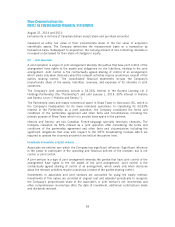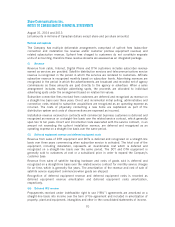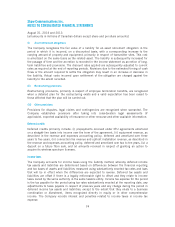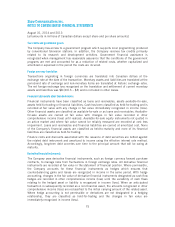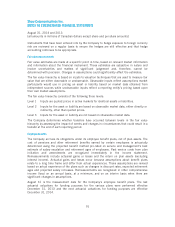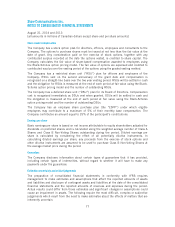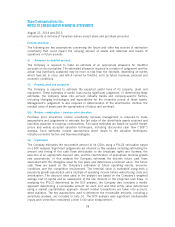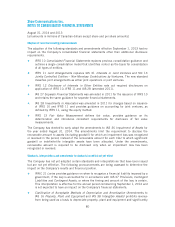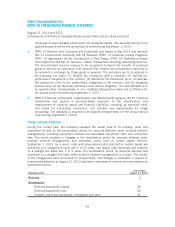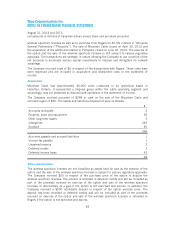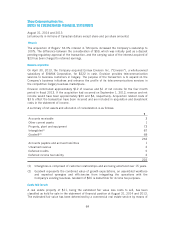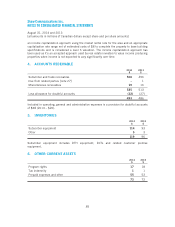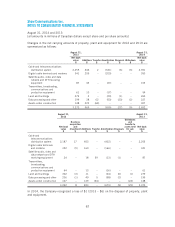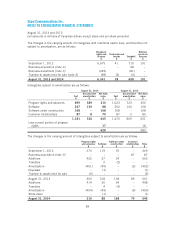Shaw 2014 Annual Report Download - page 83
Download and view the complete annual report
Please find page 83 of the 2014 Shaw annual report below. You can navigate through the pages in the report by either clicking on the pages listed below, or by using the keyword search tool below to find specific information within the annual report.Shaw Communications Inc.
NOTES TO CONSOLIDATED FINANCIAL STATEMENTS
August 31, 2014 and 2013
[all amounts in millions of Canadian dollars except share and per share amounts]
(v) Employee benefit plans
The amounts reported in the financial statements relating to the defined benefit pension plans
are determined using actuarial valuations that are based on several assumptions including the
discount rate and rate of compensation increase. While the Company believes these
assumptions are reasonable, differences in actual results or changes in assumptions could
affect employee benefit obligations and the related income statement impact. The most
significant assumption used to calculate the net employee benefit plan expense is the discount
rate. The discount rate is the interest rate used to determine the present value of the future
cash flows that is expected will be needed to settle employee benefit obligations. It is based on
the yield of long-term, high-quality corporate fixed income investments closely matching the
term of the estimated future cash flows and is reviewed and adjusted as changes required.
(vi) Income taxes
The Company is required to estimate income taxes using substantively enacted tax rates and
laws that will be in effect when the differences are expected to reverse. In determining the
measurement of tax uncertainties, the Company applies a probable weighted average
methodology. Realization of deferred income tax assets is dependent on generating sufficient
taxable income during the period in which the temporary differences are deductible. Although
realization is not assured, management believes it is more likely than not that all recognized
deferred income tax assets will be realized based on reversals of deferred income tax liabilities,
projected operating results and tax planning strategies available to the Company and its
subsidiaries.
(vii) Contingencies
The Company is subject to various claims and contingencies related to lawsuits, taxes and
commitments under contractual and other commercial obligations. Contingent losses are
recognized by a charge to income when it is likely that a future event will confirm that an asset
has been impaired or a liability incurred at the date of the financial statements and the amount
can be reasonably estimated. Significant changes in assumptions as to the likelihood and
estimates of the amount of a loss could result in recognition of additional liabilities.
Critical judgements
The following are critical judgements apart from those involving estimation:
(i) Determination of a CGU
Management’s judgement is required in determining the Company’s cash generating units for
the impairment assessment of its indefinite-life intangible assets. The CGUs have been
determined considering operating activities and asset management and are consistent with the
Company’s reporting segments, Cable, Satellite and Media.
(ii) Broadcast rights and licenses and spectrum licenses – indefinite-life assessment
The Company’s businesses are dependent upon broadcast licenses (or operate pursuant to an
exemption order) granted and issued by the CRTC. In addition, the Company holds AWS
licenses to operate a wireless system in Canada. While these licenses must be renewed from
time to time, the Company has never failed to do so. In addition, there are currently no legal,
regulatory or competitive factors that limit the useful lives of these assets.
79


